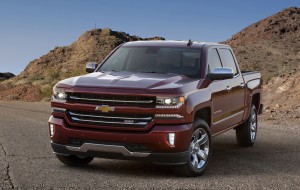A few weeks back, Chevrolet took Ford to task for its extensive of use of aluminum in its new F-150 full-size pickup. The brand mocked the strength of the material and said it’s more costly to fix in a series of ads.
Ford took minor umbrage, putting out a release essentially saying that Chevrolet was wrong and knew as much. Chevy officials simply said it was just getting its side of the story out.
Fast forward to now and what material is Chevy using to help increase fuel efficiency in its next-generation Silverado? Aluminum.
A couple days ago General Motors announced it was pumping $877 million into its Flint, Michigan, truck plant. What wasn’t mentioned in the announcement, according to Reuters, is that the overhaul is necessary because it needs to use different equipment than it currently uses to produce the new truck.

Ford may have the last laugh on the use of aluminum for trucks as Chevy is rumored to be using more of it in its new Silverado.
“People familiar with the company’s plans say GM’s next-generation pickups and SUVs will make use of various materials, including aluminum and lightweight steel, to shed weight and gain fuel efficiency to meet tougher federal standards,” Reuters reported.
The Silverado, and its GMC sibling, the Sierra, isn’t completely aluminum free right now anyway. It’s used for certain engine parts and the hood. However, if the new pickup’s aluminum uses begins to rival that of the F-150, Chevy might have some explaining to do.
(Big truck sales mean big automaker profits. For more, Click Here.)
That said, it’s tough to argue with the move to the lighter-than-steel, military-grade material as it’s cut about 700 pounds off Ford’s new model and allowed to increase sales of its trucks equipped with its EcoBoost V6 engine, improving the truck’s gas mileage significantly.
(Click Here for details about how automakers are planning to meet looming CAFE standards.)
In the interim, Ford is finally breathing a sigh of relief as sales of the aforementioned F-150 rebounded in July with a 13% year-over-year increase. The truck’s sales had been sluggish prior to last month’s impressive results causing some to wonder if the best-selling vehicle in America for the last 30-plus years might have overplayed its hand with the radical move to aluminum.
(Luxury utes, crossovers, trucks drive strong July auto sales. For more, Click Here.)
“Customers are really enjoying the new F-150. They love the technology; they love the capability of the vehicle,” said Erich Merkle, Ford sales analyst. “What’s even more interesting is that while retail sales were up 13%, we have established and are maintaining record average transaction prices of $44,000 per truck.”
Chevy and Ram have exploited the opportunity selling trucks at record levels. In fact, Silverado sales were up 33.9% in July, despite the fact that truck is due for a major makeover in the months ahead.


What distinguishes “military grade” aluminum from plain vanilla aluminum?
To my understanding it has to do with the specific alloys and how strong and ding/dent/damage resistant they are.
Paul E.
More than likely higher modulus/stiffness.
Generally speaking “MIL” spec materials are high quality and are tested and certified to specification. Aircraft quality aluminum would probably be a better description of what Ford is using as former CEO Alan Mulally came from the aircraft industry, (Boeing). “Military” sounds tougher to the casual public. Many high quality materials actually meet a variety of industry specifications and thus are multi-certified to these specs.
The Chevy ads show how gullible many U.S. consumers are as they will actually believe the bogus claims.
Ford has changed their ads to say; “High strength steel frames for maximum strength and towing capacity”.